Comprehensive Essay: Organization Change Management and Strategies
VerifiedAdded on 2019/12/03
|6
|2037
|496
Essay
AI Summary
This essay provides a comprehensive overview of organization change management. It begins by defining change management and its importance, highlighting how it helps organizations adapt to technological advancements and competitive pressures. The essay then explores the benefits of change management, emphasizing its role in increasing success, improving morale, and enhancing productivity. It differentiates between internal and external factors influencing change, providing examples such as the impact of leadership styles and economic conditions. The essay further examines planned and emergent change, explaining Lewin's Unfreeze-Change-Refreeze model and the need for emergent strategies to address unpredictable factors. Real-world examples, such as Maruti Suzuki and Nokia, illustrate the practical application of change management principles. Finally, the essay discusses the benefits gained by firms through change management, referencing the triple bottom line principle and emphasizing the importance of strategic planning and adaptability in a competitive market. The essay concludes by evaluating the implementation of change strategies, including situational awareness, supporting structures, and strategy analysis, as well as the importance of assessing the success of adopted strategies.
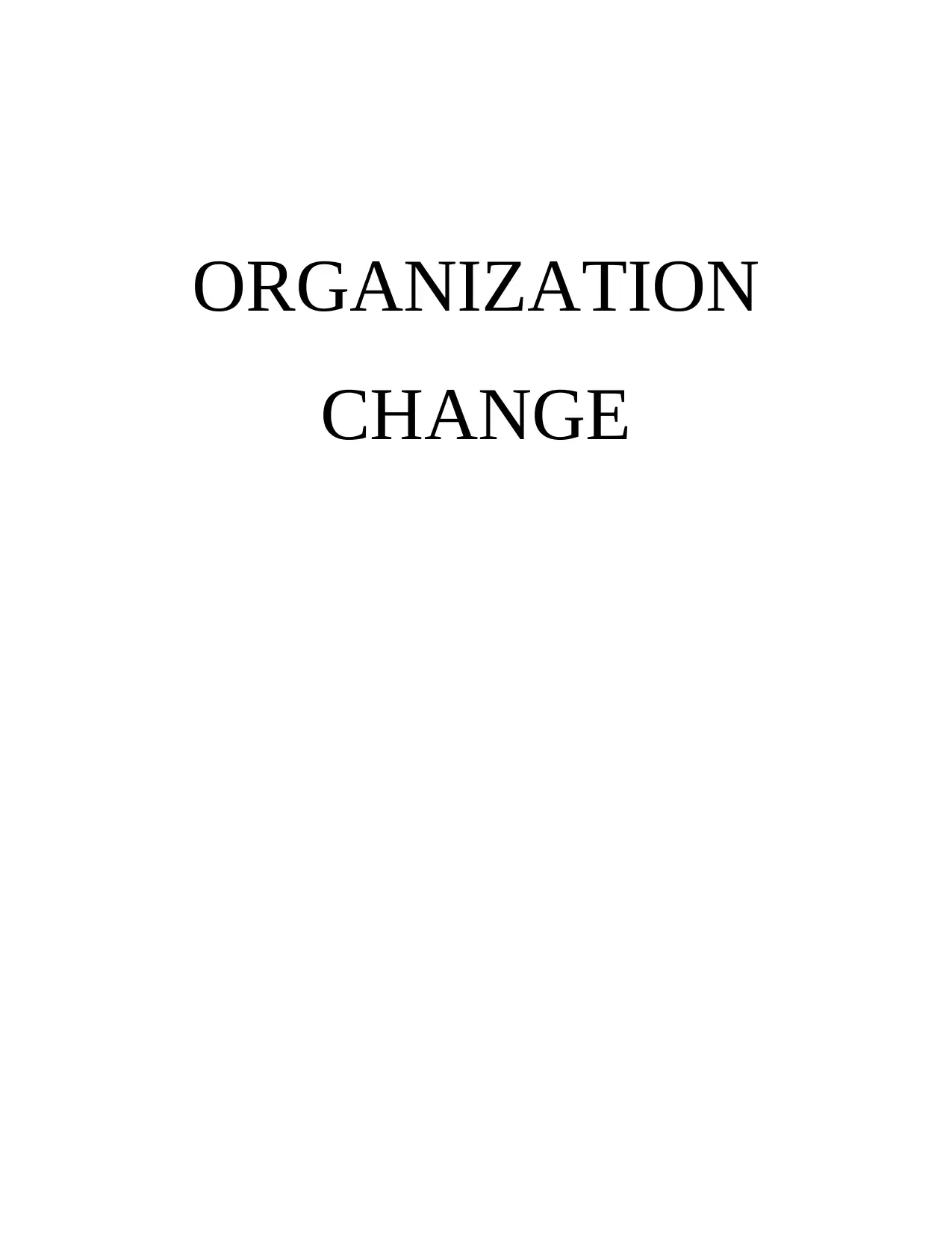
ORGANIZATION
CHANGE
CHANGE
Paraphrase This Document
Need a fresh take? Get an instant paraphrase of this document with our AI Paraphraser
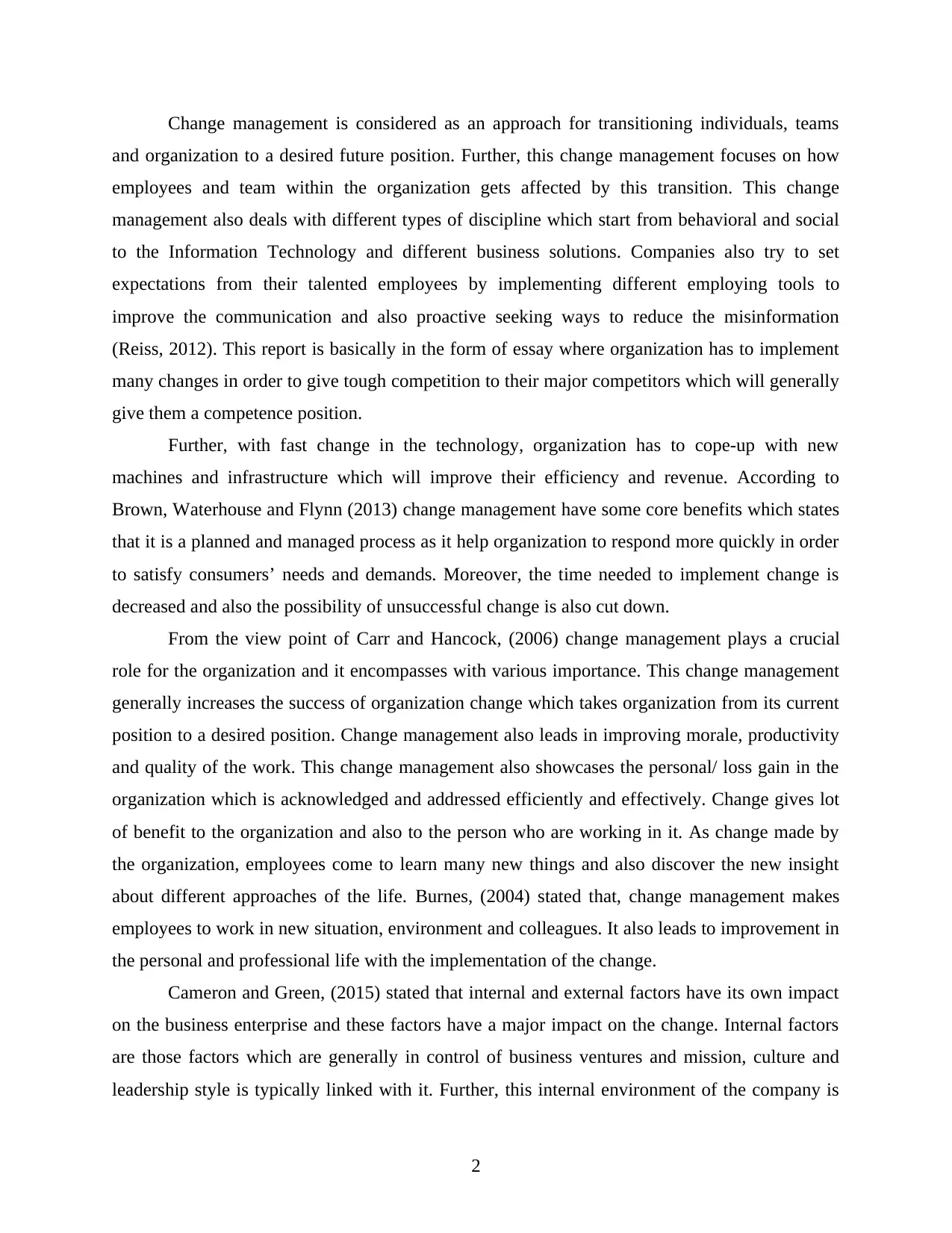
Change management is considered as an approach for transitioning individuals, teams
and organization to a desired future position. Further, this change management focuses on how
employees and team within the organization gets affected by this transition. This change
management also deals with different types of discipline which start from behavioral and social
to the Information Technology and different business solutions. Companies also try to set
expectations from their talented employees by implementing different employing tools to
improve the communication and also proactive seeking ways to reduce the misinformation
(Reiss, 2012). This report is basically in the form of essay where organization has to implement
many changes in order to give tough competition to their major competitors which will generally
give them a competence position.
Further, with fast change in the technology, organization has to cope-up with new
machines and infrastructure which will improve their efficiency and revenue. According to
Brown, Waterhouse and Flynn (2013) change management have some core benefits which states
that it is a planned and managed process as it help organization to respond more quickly in order
to satisfy consumers’ needs and demands. Moreover, the time needed to implement change is
decreased and also the possibility of unsuccessful change is also cut down.
From the view point of Carr and Hancock, (2006) change management plays a crucial
role for the organization and it encompasses with various importance. This change management
generally increases the success of organization change which takes organization from its current
position to a desired position. Change management also leads in improving morale, productivity
and quality of the work. This change management also showcases the personal/ loss gain in the
organization which is acknowledged and addressed efficiently and effectively. Change gives lot
of benefit to the organization and also to the person who are working in it. As change made by
the organization, employees come to learn many new things and also discover the new insight
about different approaches of the life. Burnes, (2004) stated that, change management makes
employees to work in new situation, environment and colleagues. It also leads to improvement in
the personal and professional life with the implementation of the change.
Cameron and Green, (2015) stated that internal and external factors have its own impact
on the business enterprise and these factors have a major impact on the change. Internal factors
are those factors which are generally in control of business ventures and mission, culture and
leadership style is typically linked with it. Further, this internal environment of the company is
2
and organization to a desired future position. Further, this change management focuses on how
employees and team within the organization gets affected by this transition. This change
management also deals with different types of discipline which start from behavioral and social
to the Information Technology and different business solutions. Companies also try to set
expectations from their talented employees by implementing different employing tools to
improve the communication and also proactive seeking ways to reduce the misinformation
(Reiss, 2012). This report is basically in the form of essay where organization has to implement
many changes in order to give tough competition to their major competitors which will generally
give them a competence position.
Further, with fast change in the technology, organization has to cope-up with new
machines and infrastructure which will improve their efficiency and revenue. According to
Brown, Waterhouse and Flynn (2013) change management have some core benefits which states
that it is a planned and managed process as it help organization to respond more quickly in order
to satisfy consumers’ needs and demands. Moreover, the time needed to implement change is
decreased and also the possibility of unsuccessful change is also cut down.
From the view point of Carr and Hancock, (2006) change management plays a crucial
role for the organization and it encompasses with various importance. This change management
generally increases the success of organization change which takes organization from its current
position to a desired position. Change management also leads in improving morale, productivity
and quality of the work. This change management also showcases the personal/ loss gain in the
organization which is acknowledged and addressed efficiently and effectively. Change gives lot
of benefit to the organization and also to the person who are working in it. As change made by
the organization, employees come to learn many new things and also discover the new insight
about different approaches of the life. Burnes, (2004) stated that, change management makes
employees to work in new situation, environment and colleagues. It also leads to improvement in
the personal and professional life with the implementation of the change.
Cameron and Green, (2015) stated that internal and external factors have its own impact
on the business enterprise and these factors have a major impact on the change. Internal factors
are those factors which are generally in control of business ventures and mission, culture and
leadership style is typically linked with it. Further, this internal environment of the company is
2
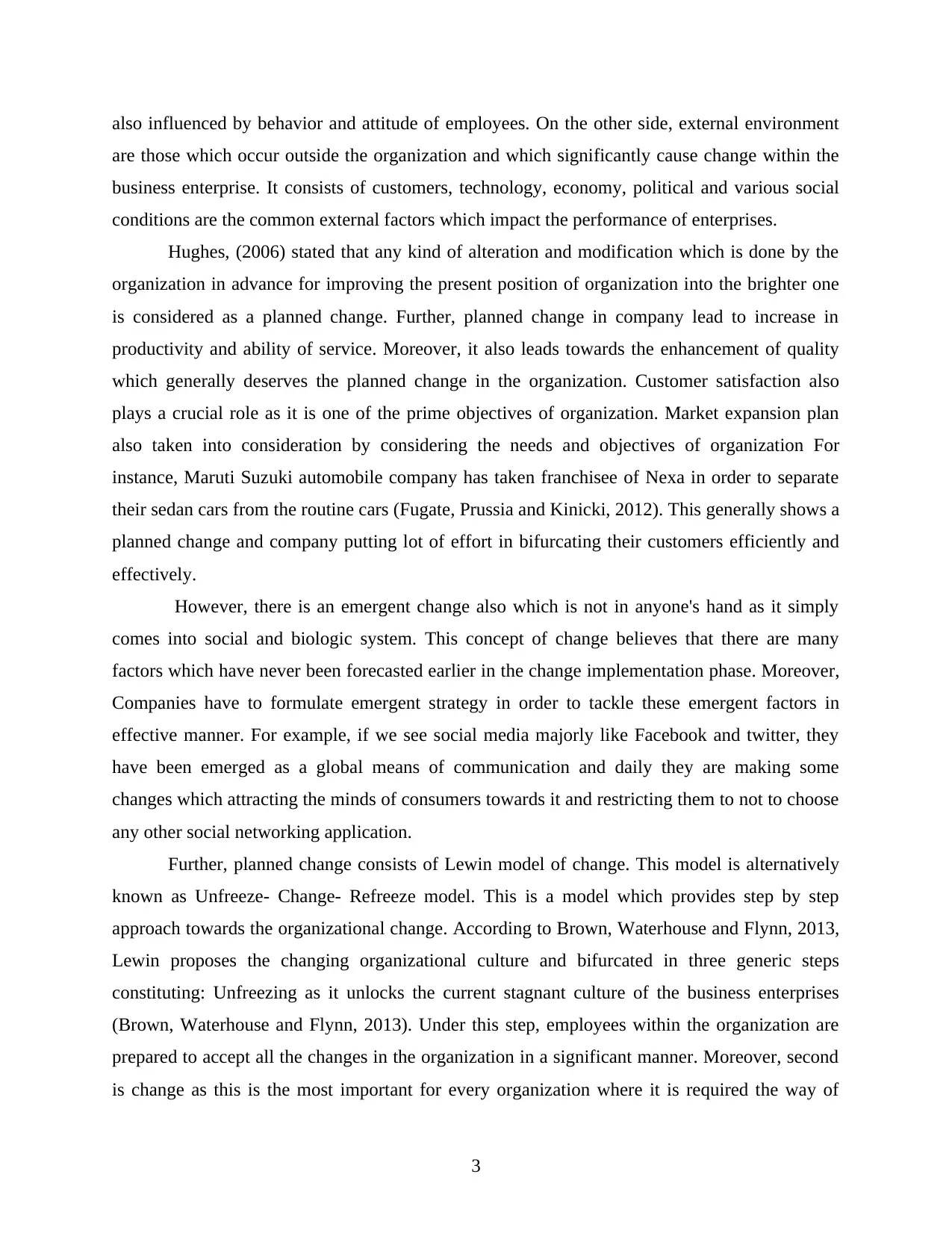
also influenced by behavior and attitude of employees. On the other side, external environment
are those which occur outside the organization and which significantly cause change within the
business enterprise. It consists of customers, technology, economy, political and various social
conditions are the common external factors which impact the performance of enterprises.
Hughes, (2006) stated that any kind of alteration and modification which is done by the
organization in advance for improving the present position of organization into the brighter one
is considered as a planned change. Further, planned change in company lead to increase in
productivity and ability of service. Moreover, it also leads towards the enhancement of quality
which generally deserves the planned change in the organization. Customer satisfaction also
plays a crucial role as it is one of the prime objectives of organization. Market expansion plan
also taken into consideration by considering the needs and objectives of organization For
instance, Maruti Suzuki automobile company has taken franchisee of Nexa in order to separate
their sedan cars from the routine cars (Fugate, Prussia and Kinicki, 2012). This generally shows a
planned change and company putting lot of effort in bifurcating their customers efficiently and
effectively.
However, there is an emergent change also which is not in anyone's hand as it simply
comes into social and biologic system. This concept of change believes that there are many
factors which have never been forecasted earlier in the change implementation phase. Moreover,
Companies have to formulate emergent strategy in order to tackle these emergent factors in
effective manner. For example, if we see social media majorly like Facebook and twitter, they
have been emerged as a global means of communication and daily they are making some
changes which attracting the minds of consumers towards it and restricting them to not to choose
any other social networking application.
Further, planned change consists of Lewin model of change. This model is alternatively
known as Unfreeze- Change- Refreeze model. This is a model which provides step by step
approach towards the organizational change. According to Brown, Waterhouse and Flynn, 2013,
Lewin proposes the changing organizational culture and bifurcated in three generic steps
constituting: Unfreezing as it unlocks the current stagnant culture of the business enterprises
(Brown, Waterhouse and Flynn, 2013). Under this step, employees within the organization are
prepared to accept all the changes in the organization in a significant manner. Moreover, second
is change as this is the most important for every organization where it is required the way of
3
are those which occur outside the organization and which significantly cause change within the
business enterprise. It consists of customers, technology, economy, political and various social
conditions are the common external factors which impact the performance of enterprises.
Hughes, (2006) stated that any kind of alteration and modification which is done by the
organization in advance for improving the present position of organization into the brighter one
is considered as a planned change. Further, planned change in company lead to increase in
productivity and ability of service. Moreover, it also leads towards the enhancement of quality
which generally deserves the planned change in the organization. Customer satisfaction also
plays a crucial role as it is one of the prime objectives of organization. Market expansion plan
also taken into consideration by considering the needs and objectives of organization For
instance, Maruti Suzuki automobile company has taken franchisee of Nexa in order to separate
their sedan cars from the routine cars (Fugate, Prussia and Kinicki, 2012). This generally shows a
planned change and company putting lot of effort in bifurcating their customers efficiently and
effectively.
However, there is an emergent change also which is not in anyone's hand as it simply
comes into social and biologic system. This concept of change believes that there are many
factors which have never been forecasted earlier in the change implementation phase. Moreover,
Companies have to formulate emergent strategy in order to tackle these emergent factors in
effective manner. For example, if we see social media majorly like Facebook and twitter, they
have been emerged as a global means of communication and daily they are making some
changes which attracting the minds of consumers towards it and restricting them to not to choose
any other social networking application.
Further, planned change consists of Lewin model of change. This model is alternatively
known as Unfreeze- Change- Refreeze model. This is a model which provides step by step
approach towards the organizational change. According to Brown, Waterhouse and Flynn, 2013,
Lewin proposes the changing organizational culture and bifurcated in three generic steps
constituting: Unfreezing as it unlocks the current stagnant culture of the business enterprises
(Brown, Waterhouse and Flynn, 2013). Under this step, employees within the organization are
prepared to accept all the changes in the organization in a significant manner. Moreover, second
is change as this is the most important for every organization where it is required the way of
3
⊘ This is a preview!⊘
Do you want full access?
Subscribe today to unlock all pages.

Trusted by 1+ million students worldwide
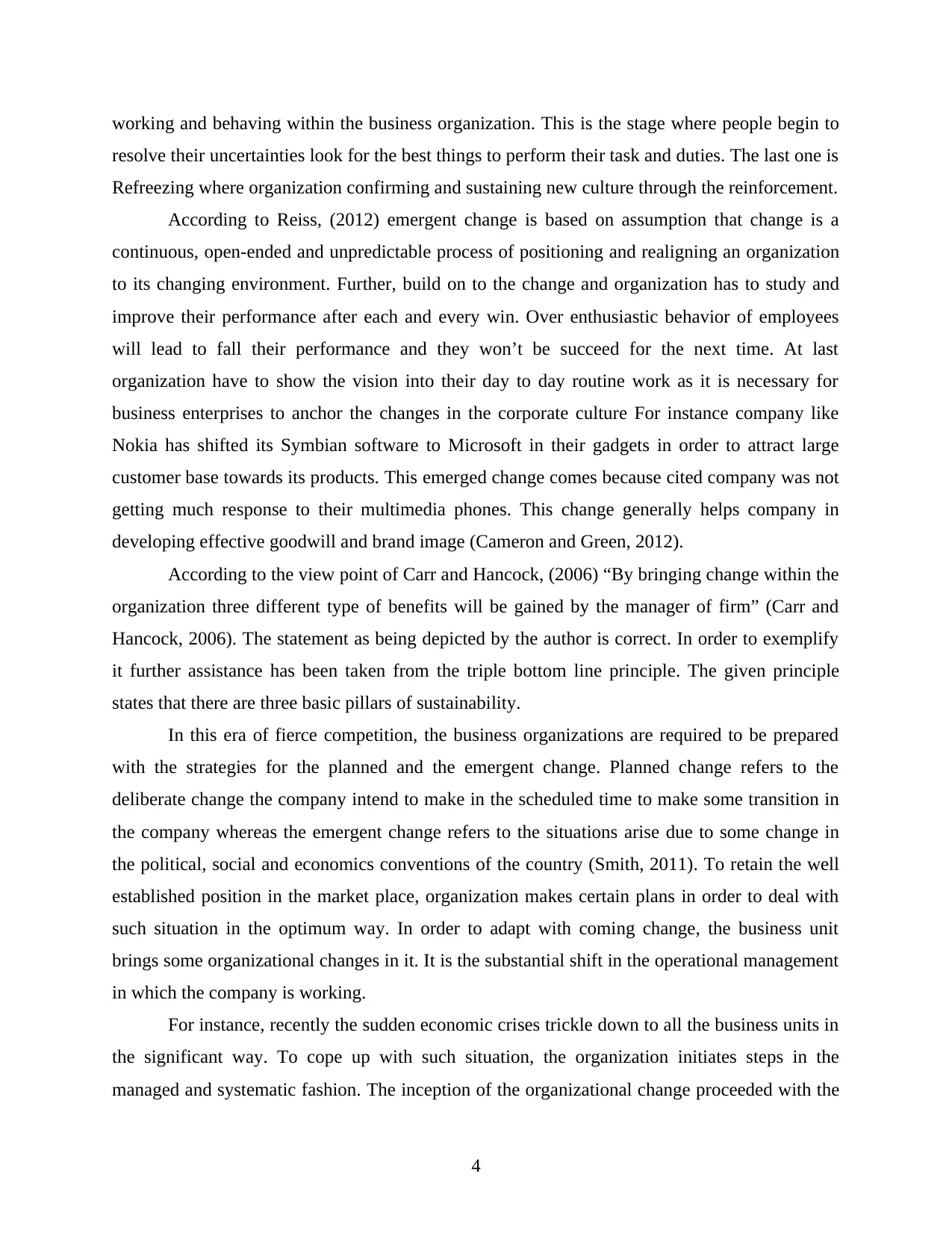
working and behaving within the business organization. This is the stage where people begin to
resolve their uncertainties look for the best things to perform their task and duties. The last one is
Refreezing where organization confirming and sustaining new culture through the reinforcement.
According to Reiss, (2012) emergent change is based on assumption that change is a
continuous, open-ended and unpredictable process of positioning and realigning an organization
to its changing environment. Further, build on to the change and organization has to study and
improve their performance after each and every win. Over enthusiastic behavior of employees
will lead to fall their performance and they won’t be succeed for the next time. At last
organization have to show the vision into their day to day routine work as it is necessary for
business enterprises to anchor the changes in the corporate culture For instance company like
Nokia has shifted its Symbian software to Microsoft in their gadgets in order to attract large
customer base towards its products. This emerged change comes because cited company was not
getting much response to their multimedia phones. This change generally helps company in
developing effective goodwill and brand image (Cameron and Green, 2012).
According to the view point of Carr and Hancock, (2006) “By bringing change within the
organization three different type of benefits will be gained by the manager of firm” (Carr and
Hancock, 2006). The statement as being depicted by the author is correct. In order to exemplify
it further assistance has been taken from the triple bottom line principle. The given principle
states that there are three basic pillars of sustainability.
In this era of fierce competition, the business organizations are required to be prepared
with the strategies for the planned and the emergent change. Planned change refers to the
deliberate change the company intend to make in the scheduled time to make some transition in
the company whereas the emergent change refers to the situations arise due to some change in
the political, social and economics conventions of the country (Smith, 2011). To retain the well
established position in the market place, organization makes certain plans in order to deal with
such situation in the optimum way. In order to adapt with coming change, the business unit
brings some organizational changes in it. It is the substantial shift in the operational management
in which the company is working.
For instance, recently the sudden economic crises trickle down to all the business units in
the significant way. To cope up with such situation, the organization initiates steps in the
managed and systematic fashion. The inception of the organizational change proceeded with the
4
resolve their uncertainties look for the best things to perform their task and duties. The last one is
Refreezing where organization confirming and sustaining new culture through the reinforcement.
According to Reiss, (2012) emergent change is based on assumption that change is a
continuous, open-ended and unpredictable process of positioning and realigning an organization
to its changing environment. Further, build on to the change and organization has to study and
improve their performance after each and every win. Over enthusiastic behavior of employees
will lead to fall their performance and they won’t be succeed for the next time. At last
organization have to show the vision into their day to day routine work as it is necessary for
business enterprises to anchor the changes in the corporate culture For instance company like
Nokia has shifted its Symbian software to Microsoft in their gadgets in order to attract large
customer base towards its products. This emerged change comes because cited company was not
getting much response to their multimedia phones. This change generally helps company in
developing effective goodwill and brand image (Cameron and Green, 2012).
According to the view point of Carr and Hancock, (2006) “By bringing change within the
organization three different type of benefits will be gained by the manager of firm” (Carr and
Hancock, 2006). The statement as being depicted by the author is correct. In order to exemplify
it further assistance has been taken from the triple bottom line principle. The given principle
states that there are three basic pillars of sustainability.
In this era of fierce competition, the business organizations are required to be prepared
with the strategies for the planned and the emergent change. Planned change refers to the
deliberate change the company intend to make in the scheduled time to make some transition in
the company whereas the emergent change refers to the situations arise due to some change in
the political, social and economics conventions of the country (Smith, 2011). To retain the well
established position in the market place, organization makes certain plans in order to deal with
such situation in the optimum way. In order to adapt with coming change, the business unit
brings some organizational changes in it. It is the substantial shift in the operational management
in which the company is working.
For instance, recently the sudden economic crises trickle down to all the business units in
the significant way. To cope up with such situation, the organization initiates steps in the
managed and systematic fashion. The inception of the organizational change proceeded with the
4
Paraphrase This Document
Need a fresh take? Get an instant paraphrase of this document with our AI Paraphraser
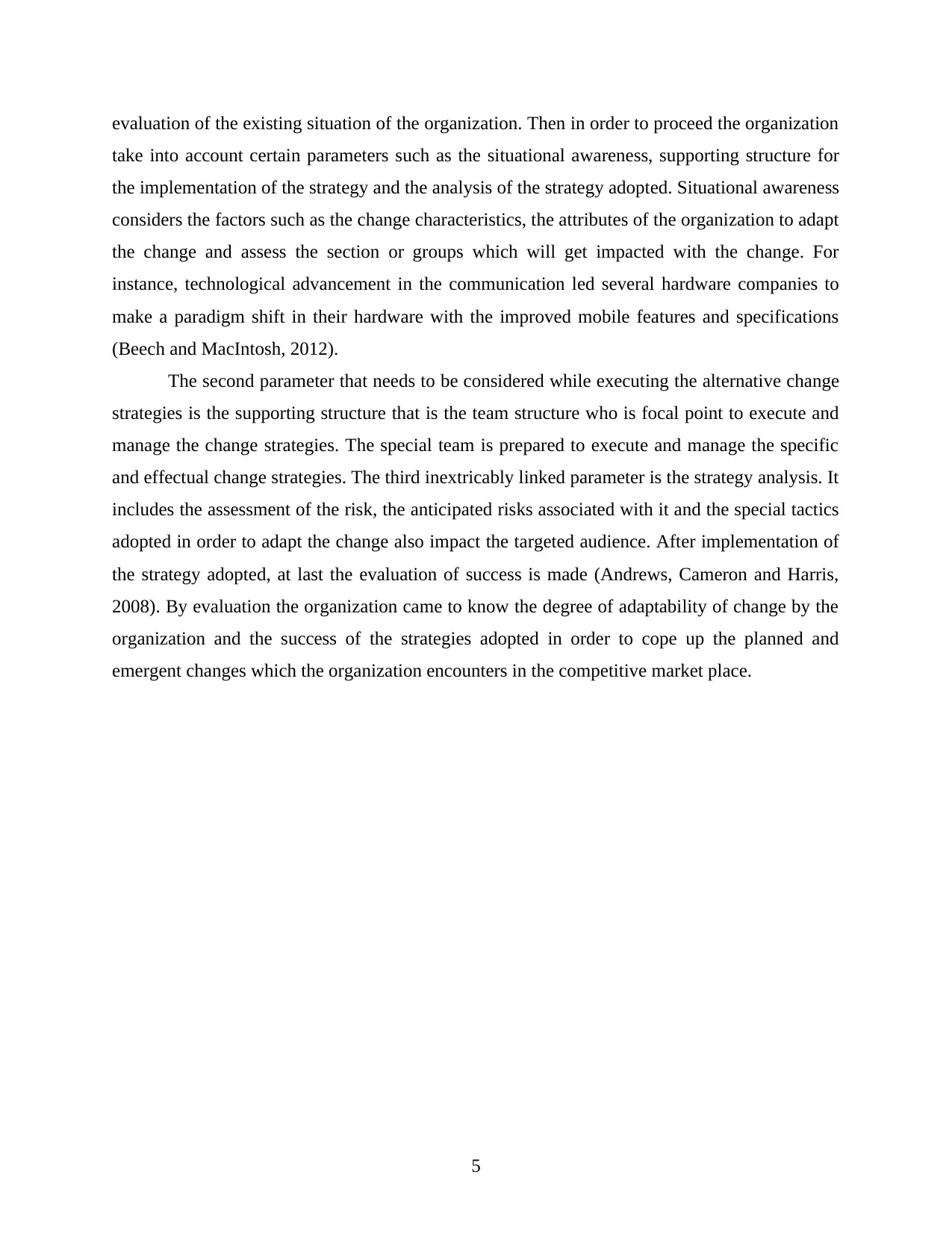
evaluation of the existing situation of the organization. Then in order to proceed the organization
take into account certain parameters such as the situational awareness, supporting structure for
the implementation of the strategy and the analysis of the strategy adopted. Situational awareness
considers the factors such as the change characteristics, the attributes of the organization to adapt
the change and assess the section or groups which will get impacted with the change. For
instance, technological advancement in the communication led several hardware companies to
make a paradigm shift in their hardware with the improved mobile features and specifications
(Beech and MacIntosh, 2012).
The second parameter that needs to be considered while executing the alternative change
strategies is the supporting structure that is the team structure who is focal point to execute and
manage the change strategies. The special team is prepared to execute and manage the specific
and effectual change strategies. The third inextricably linked parameter is the strategy analysis. It
includes the assessment of the risk, the anticipated risks associated with it and the special tactics
adopted in order to adapt the change also impact the targeted audience. After implementation of
the strategy adopted, at last the evaluation of success is made (Andrews, Cameron and Harris,
2008). By evaluation the organization came to know the degree of adaptability of change by the
organization and the success of the strategies adopted in order to cope up the planned and
emergent changes which the organization encounters in the competitive market place.
5
take into account certain parameters such as the situational awareness, supporting structure for
the implementation of the strategy and the analysis of the strategy adopted. Situational awareness
considers the factors such as the change characteristics, the attributes of the organization to adapt
the change and assess the section or groups which will get impacted with the change. For
instance, technological advancement in the communication led several hardware companies to
make a paradigm shift in their hardware with the improved mobile features and specifications
(Beech and MacIntosh, 2012).
The second parameter that needs to be considered while executing the alternative change
strategies is the supporting structure that is the team structure who is focal point to execute and
manage the change strategies. The special team is prepared to execute and manage the specific
and effectual change strategies. The third inextricably linked parameter is the strategy analysis. It
includes the assessment of the risk, the anticipated risks associated with it and the special tactics
adopted in order to adapt the change also impact the targeted audience. After implementation of
the strategy adopted, at last the evaluation of success is made (Andrews, Cameron and Harris,
2008). By evaluation the organization came to know the degree of adaptability of change by the
organization and the success of the strategies adopted in order to cope up the planned and
emergent changes which the organization encounters in the competitive market place.
5
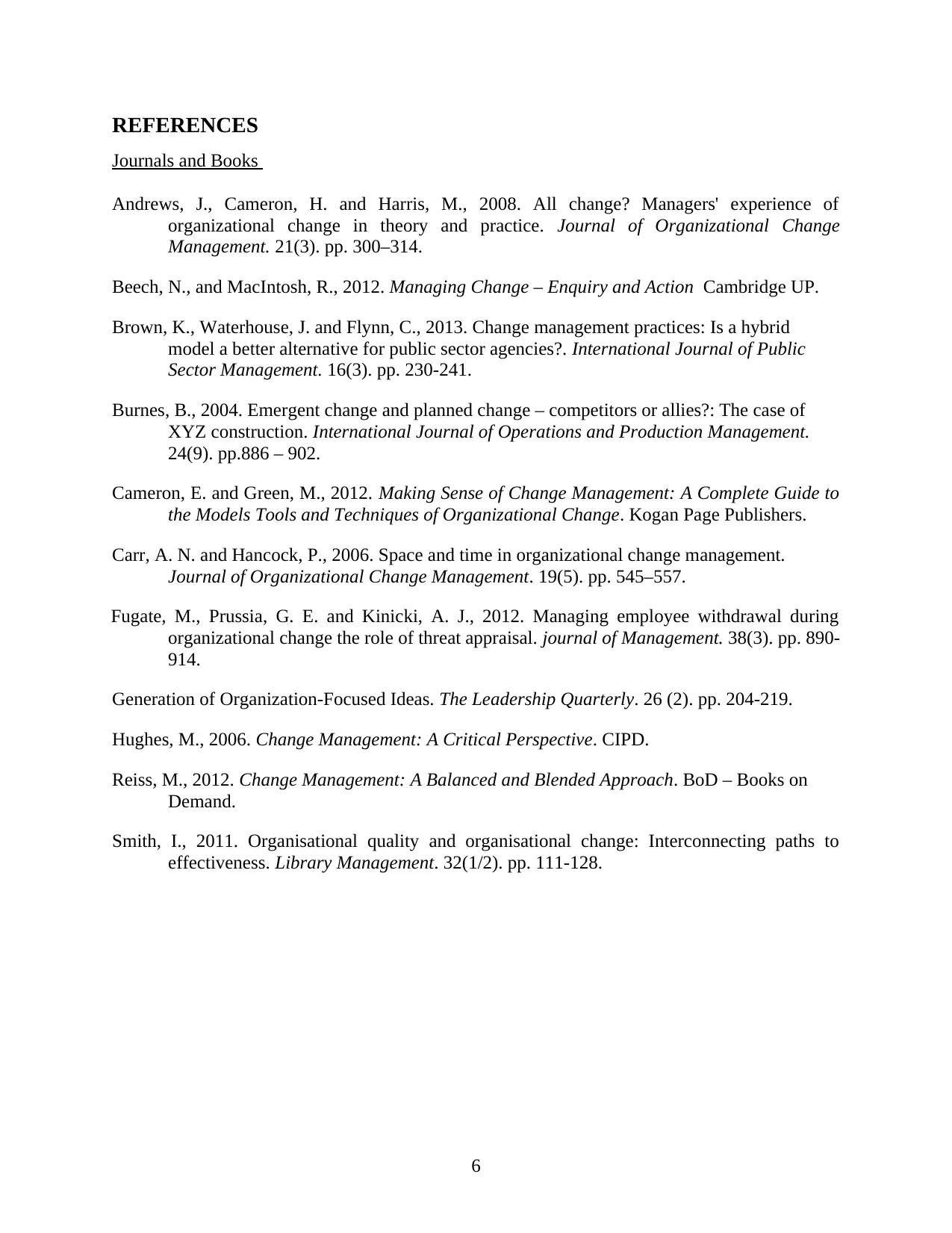
REFERENCES
Journals and Books
Andrews, J., Cameron, H. and Harris, M., 2008. All change? Managers' experience of
organizational change in theory and practice. Journal of Organizational Change
Management. 21(3). pp. 300–314.
Beech, N., and MacIntosh, R., 2012. Managing Change – Enquiry and Action Cambridge UP.
Brown, K., Waterhouse, J. and Flynn, C., 2013. Change management practices: Is a hybrid
model a better alternative for public sector agencies?. International Journal of Public
Sector Management. 16(3). pp. 230-241.
Burnes, B., 2004. Emergent change and planned change – competitors or allies?: The case of
XYZ construction. International Journal of Operations and Production Management.
24(9). pp.886 – 902.
Cameron, E. and Green, M., 2012. Making Sense of Change Management: A Complete Guide to
the Models Tools and Techniques of Organizational Change. Kogan Page Publishers.
Carr, A. N. and Hancock, P., 2006. Space and time in organizational change management.
Journal of Organizational Change Management. 19(5). pp. 545–557.
Fugate, M., Prussia, G. E. and Kinicki, A. J., 2012. Managing employee withdrawal during
organizational change the role of threat appraisal. journal of Management. 38(3). pp. 890-
914.
Generation of Organization-Focused Ideas. The Leadership Quarterly. 26 (2). pp. 204-219.
Hughes, M., 2006. Change Management: A Critical Perspective. CIPD.
Reiss, M., 2012. Change Management: A Balanced and Blended Approach. BoD – Books on
Demand.
Smith, I., 2011. Organisational quality and organisational change: Interconnecting paths to
effectiveness. Library Management. 32(1/2). pp. 111-128.
6
Journals and Books
Andrews, J., Cameron, H. and Harris, M., 2008. All change? Managers' experience of
organizational change in theory and practice. Journal of Organizational Change
Management. 21(3). pp. 300–314.
Beech, N., and MacIntosh, R., 2012. Managing Change – Enquiry and Action Cambridge UP.
Brown, K., Waterhouse, J. and Flynn, C., 2013. Change management practices: Is a hybrid
model a better alternative for public sector agencies?. International Journal of Public
Sector Management. 16(3). pp. 230-241.
Burnes, B., 2004. Emergent change and planned change – competitors or allies?: The case of
XYZ construction. International Journal of Operations and Production Management.
24(9). pp.886 – 902.
Cameron, E. and Green, M., 2012. Making Sense of Change Management: A Complete Guide to
the Models Tools and Techniques of Organizational Change. Kogan Page Publishers.
Carr, A. N. and Hancock, P., 2006. Space and time in organizational change management.
Journal of Organizational Change Management. 19(5). pp. 545–557.
Fugate, M., Prussia, G. E. and Kinicki, A. J., 2012. Managing employee withdrawal during
organizational change the role of threat appraisal. journal of Management. 38(3). pp. 890-
914.
Generation of Organization-Focused Ideas. The Leadership Quarterly. 26 (2). pp. 204-219.
Hughes, M., 2006. Change Management: A Critical Perspective. CIPD.
Reiss, M., 2012. Change Management: A Balanced and Blended Approach. BoD – Books on
Demand.
Smith, I., 2011. Organisational quality and organisational change: Interconnecting paths to
effectiveness. Library Management. 32(1/2). pp. 111-128.
6
⊘ This is a preview!⊘
Do you want full access?
Subscribe today to unlock all pages.

Trusted by 1+ million students worldwide
1 out of 6
Related Documents
Your All-in-One AI-Powered Toolkit for Academic Success.
+13062052269
info@desklib.com
Available 24*7 on WhatsApp / Email
![[object Object]](/_next/static/media/star-bottom.7253800d.svg)
Unlock your academic potential
Copyright © 2020–2025 A2Z Services. All Rights Reserved. Developed and managed by ZUCOL.





